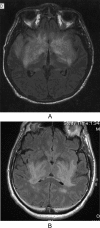Neurological complications of solid organ transplantation
- PMID: 24167649
- PMCID: PMC3805438
- DOI: 10.1177/1941874412466090
Neurological complications of solid organ transplantation
Abstract
Solid organ transplantation (SOT) is the preferred treatment for an expanding range of conditions whose successful therapy has produced a growing population of chronically immunosuppressed patients with potential neurological problems. While the spectrum of neurological complications varies with the type of organ transplanted, the indication for the procedure, and the intensity of long-term required immunosuppression, major neurological complications occur with all SOT types. The second part of this 2-part article on transplantation neurology reviews central and peripheral nervous system problems associated with SOT with clinical and neuroimaging examples from the authors' institutional experience. Particular emphasis is given to conditions acquired from the donated organ or tissue, problems specific to types of organs transplanted and drug therapy-related complications likely to be encountered by hospitalists. Neurologically important syndromes such as immune reconstitution inflammatory syndrome (IRIS), posterior reversible encephalopathy syndrome (PRES), and posttransplantation lymphoproliferative disorder (PTLD) are readdressed in the context of SOT.
Keywords: hepatic encephalopathy; immune reconstitution inflammatory syndrome; organ transplantation; posterior reversible encephalopathy syndrome; posttransplantation lymphoproliferative disorder; progressive multifocal leukoencephalopathy; toxoplasmosis.
Conflict of interest statement
Figures






References
-
- Organ Procurement and Transplantation Network. http://optn.transplant.hrsa.gov Accessed March 24, 2012
-
- Senzolo M, Ferronato C, Burra P. Neurologic complications after solid organ transplantation. Transpl Int. 2009;22(3):269–278 - PubMed
-
- Dhar R, Human T. Central nervous system complications after transplantation. Neurol Clin, 2011;29(4):943–972 - PubMed
-
- Pustavoitau A, Bhardwaj A, Stevens R. Neurological complications of transplantation. J Intensive Care Med. 2011;26(4):209–222 - PubMed
-
- Sharma P, Eesa M, Scott JN. Toxic and acquired metabolic encephalopathies: MRI appearance. AJR Am J Roentgenol 2009;193(3):879–886 - PubMed
LinkOut - more resources
Full Text Sources
Other Literature Sources
